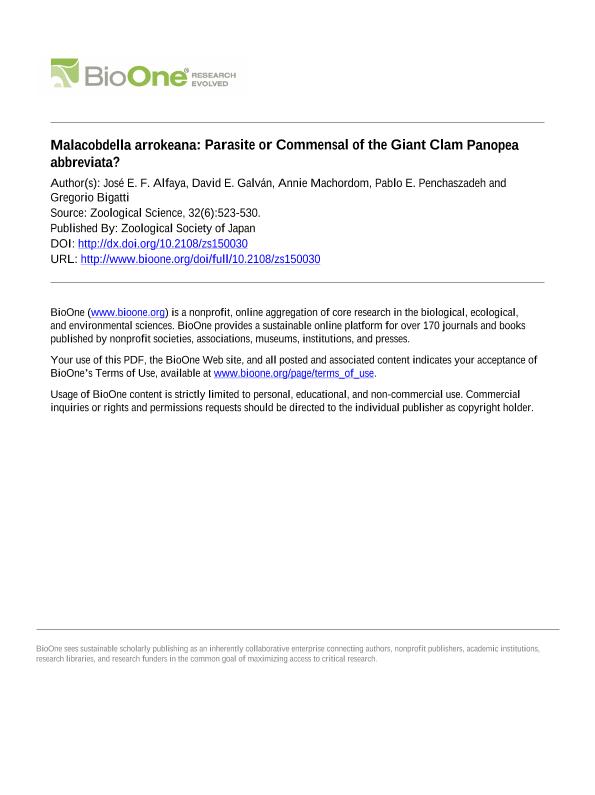Mostrar el registro sencillo del ítem
dc.contributor.author
Fernandez Alfaya, Jose Elias

dc.contributor.author
Galvan, David Edgardo

dc.contributor.author
Machordom Barbe, Annie

dc.contributor.author
Penchaszadeh, Pablo Enrique

dc.contributor.author
Bigatti, Gregorio

dc.date.available
2018-05-10T14:16:20Z
dc.date.issued
2015-12
dc.identifier.citation
Fernandez Alfaya, Jose Elias; Galvan, David Edgardo; Machordom Barbe, Annie; Penchaszadeh, Pablo Enrique; Bigatti, Gregorio; Malacobdella arrokeana: Parasite or Commensal of the Giant Clam Panopea abbreviata?
; Zoological Society of Japan; Zoological Science; 32; 6; 12-2015; 523-530
dc.identifier.issn
0289-0003
dc.identifier.uri
http://hdl.handle.net/11336/44741
dc.description.abstract
We examined trophic relationship between the nemertean Malacobdella arrokeana and its host, the edible geoduck Panopea abbreviata by studying the diets of both species by direct (stomach contents) and indirect methods (stable-isotope analysis of C and N). In addition to these methods, the feeding behavior of M. arrokeana within the host and the morphology of its feeding organs were examined. The feeding behavior of M. arrokeana did not exhibit parasitic characteristics, and the proboscis morphology indicates it is unable to injure host tissues. Analysis of stomach contents revealed a diet consisting mainly of microalgae and diatoms. Panopea abbreviata and M. arrokeanashared similar trophic levels, presenting no differences in the spread of the isotopic niches and high overlap (SEAB overlapped 63%). Consistent with this, our results showed no differences in δδ15N or δδ13C values between the two species. The combination of direct and indirect approaches revealed that M. arrokeana has a diet similar to that of its host, confirming a commensal relationship.
dc.format
application/pdf
dc.language.iso
eng
dc.publisher
Zoological Society of Japan

dc.rights
info:eu-repo/semantics/openAccess
dc.rights.uri
https://creativecommons.org/licenses/by-nc-sa/2.5/ar/
dc.subject
Commensal Nemertean
dc.subject
Stable Isotopes
dc.subject
Feeding Behavior
dc.subject
Diet
dc.subject
Hoplonemertea
dc.subject
Proboscis Morphology
dc.subject
Bivalves
dc.subject.classification
Otras Ciencias Biológicas

dc.subject.classification
Ciencias Biológicas

dc.subject.classification
CIENCIAS NATURALES Y EXACTAS

dc.title
Malacobdella arrokeana: Parasite or Commensal of the Giant Clam Panopea abbreviata?
dc.type
info:eu-repo/semantics/article
dc.type
info:ar-repo/semantics/artículo
dc.type
info:eu-repo/semantics/publishedVersion
dc.date.updated
2018-05-02T18:14:19Z
dc.journal.volume
32
dc.journal.number
6
dc.journal.pagination
523-530
dc.journal.pais
Japón

dc.journal.ciudad
Tokyo
dc.description.fil
Fil: Fernandez Alfaya, Jose Elias. Consejo Nacional de Investigaciones Científicas y Técnicas. Centro Científico Tecnológico Conicet - Centro Nacional Patagónico. Instituto de Biología de Organismos Marinos; Argentina. Universidad Nacional de la Patagonia; Argentina
dc.description.fil
Fil: Galvan, David Edgardo. Consejo Nacional de Investigaciones Científicas y Técnicas. Centro Científico Tecnológico Conicet - Centro Nacional Patagónico. Centro para el Estudio de Sistemas Marinos; Argentina
dc.description.fil
Fil: Machordom Barbe, Annie. Museo Nacional de Ciencias Naturales; España
dc.description.fil
Fil: Penchaszadeh, Pablo Enrique. Consejo Nacional de Investigaciones Científicas y Técnicas. Oficina de Coordinación Administrativa Parque Centenario. Museo Argentino de Ciencias Naturales ; Argentina
dc.description.fil
Fil: Bigatti, Gregorio. Consejo Nacional de Investigaciones Científicas y Técnicas. Centro Científico Tecnológico Conicet - Centro Nacional Patagónico. Instituto de Biología de Organismos Marinos; Argentina. Universidad Nacional de la Patagonia; Argentina
dc.journal.title
Zoological Science

dc.relation.alternativeid
info:eu-repo/semantics/altIdentifier/doi/http://dx.doi.org/10.2108/zs150030
dc.relation.alternativeid
info:eu-repo/semantics/altIdentifier/url/http://www.bioone.org/doi/10.2108/zs150030
Archivos asociados
